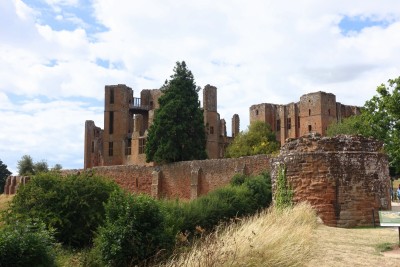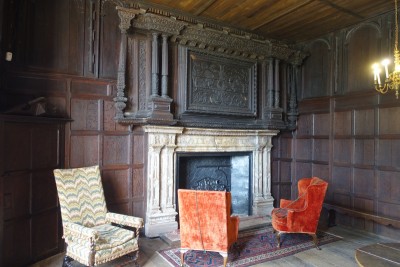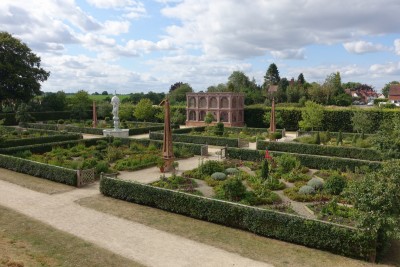Kenilworth Castle: fit for a Queen
(vero;2022-July-15)
You can also check our photo gallery dedicated to Kenilworth Castle.
Kenilworth Castle, south of Coventry and near Warwick is a castle steeped in history. It is mainly the creation of three men:Geoffrey de Clinton, John of Gaunt and Robert Dudley. 
The first structure, the sturdy Norman keep, was built in the 1120s by one Geoffrey de Clinton (died 1134), an influential chamberlain and treasurer to the King Henry I of England (1068-1135), son of William the Conqueror.
The castle passed to the Crown at the end of the 12th century and saw major improvements in the early 13th century when King John Lackland (1166-1216) added an outer fortification wall with towers and built a dyke to enlarge the nearby mere (lake) so that it surrounded the castle, making Kenilworth one of the most formidable fortresses in the kingdom. And indeed the castle survived the longest siege in English history in the year 1266.
King Edward III (1312-1377) gave the castle to his youngest son John of Gaunt Duke of Lancaster (1340-1399), who transformed it into a residential palace, building the great hall and lavish apartments.
The castle remained in the Crown until Henry VIII (1491-1547) gave it to his favourite John Dudley, Earl of Warwick and 1st Duke of Northumberland.
Unfortunately, John Dudley lost his head (literally) in 1553 for trying to place Lady Jane Grey on the English throne after the death of Edward VI, son of Henry VIII and Jane Seymour; something that the Catholic Queen Mary, "Bloody Mary", daughter of Henry VIII and Catherine of Aragon did not forgive him once she was on the throne.
This was a reversal of fortune for the Dudley family, but fortunately it was short-lived because once on the throne, Queen Elizabeth I (1533-1603), daughter of Henry VIII and Anne Boleyn gave Kenilworth back to John's son, Robert Dudley (1532-1588) who happened to be her favourite, granting him the title of 1st Earl of Leicester in the process.
 This is where it gets interesting: you probably know that Elizabeth I, the Virgin Queen, never married, but Dudley was her protégé, her favourite, and it seems that she was in love with him. She would have married him but the diplomacy of the time wanted a royal and foreign husband for the Queen so she preferred not to. Robert or no one. On his side, Robert was much enamoured with Elizabeth but was a married man. He proposed to her several times after his wife's death but he was always refused.
This is where it gets interesting: you probably know that Elizabeth I, the Virgin Queen, never married, but Dudley was her protégé, her favourite, and it seems that she was in love with him. She would have married him but the diplomacy of the time wanted a royal and foreign husband for the Queen so she preferred not to. Robert or no one. On his side, Robert was much enamoured with Elizabeth but was a married man. He proposed to her several times after his wife's death but he was always refused.
Robert made a point of transforming Kenilworth into a castle worthy of his Queen. The court visited Kenilworth four times: in 1565, 1568, 1572 and finally 1575. Dudley went to great lengths to welcome her: he built a new princely building next to the old ones with private apartments furnished with great luxury just for her. He also created a pleasure garden just to please her, organised parties and magnificent tournaments just to amuse her. The festivities for her last visit in 1575 were particularly magnificent and are said to have inspired Shakespeare's "A Midsummer Night's Dream";  the Queen stayed three weeks, which was quite unheard of. This was also the last time Robert proposed to her. But all his efforts had been in vain: he was refused yet again. They remained friends nevertheless. Click here to read about Elizabeth and Robert's story.
the Queen stayed three weeks, which was quite unheard of. This was also the last time Robert proposed to her. But all his efforts had been in vain: he was refused yet again. They remained friends nevertheless. Click here to read about Elizabeth and Robert's story.
Then came the turbulent times of the English Civil War: Kenilworth was taken by the Parliamentarian army in the opening month of the Civil War (August 1642) but the castle saw no substantial action. In 1649, anxious to avoid the cost of maintaining a garrison to protect it from a Royalist attack, the new regime ordered that Kenilworth be made indefensible so the north wall of the keep was destroyed and the outer curtain wall breached. A certain Colonel Hawkesworth bought the castle after the Civil War on behalf of a group of Parliamentary soldiers: he split the estate among his comrades and started dismantling the castle in the years that followed. The mere was drained, trees were felled, and interiors stripped out and sold. Only Leicester House was spared and became a private house. Kenilworth never recovered and fell into ruin.
Later, the ruins became famous and attracted Victorian visitors thanks in part to Walter Scott's 1821 novel Kenilworth, which romanticised the story of Robert Dudley, his wife Amy Robsart, and Elizabeth I.
Don't forget to check our photo gallery of Kenilworth Castle.
Want to read more? Go back to Petworth House: grand palatial house turned museum or go up to Blog
$ updated from: Blog.htxt Mon 28 Apr 2025 14:55:35 trvl2 — Copyright © 2025 Vero and Thomas Lauer unless otherwise stated | All rights reserved $



